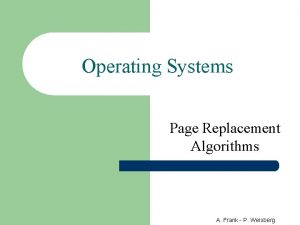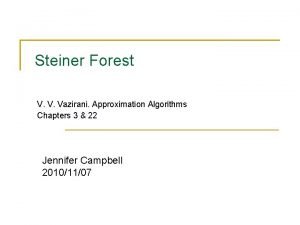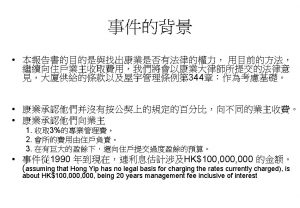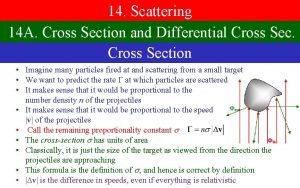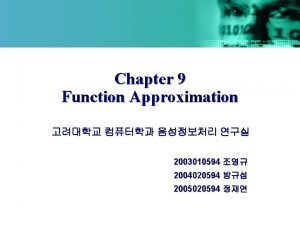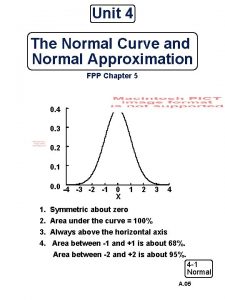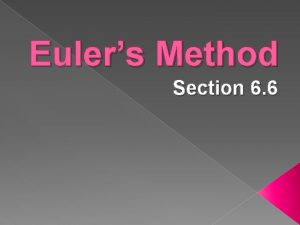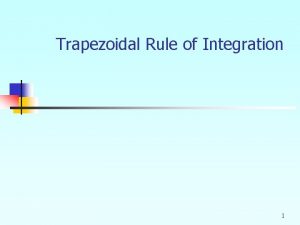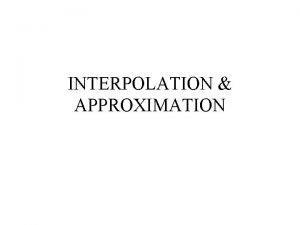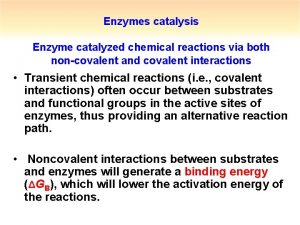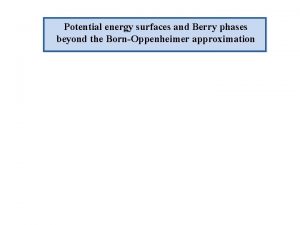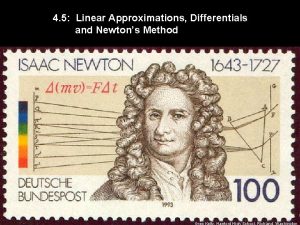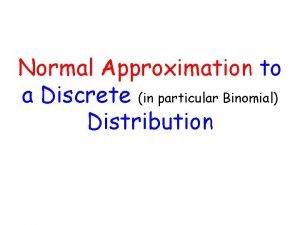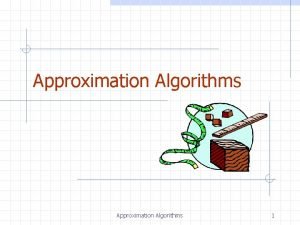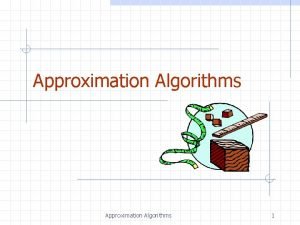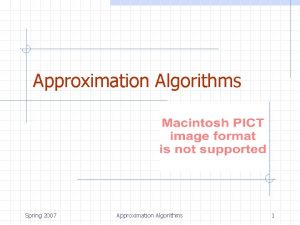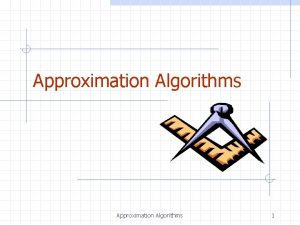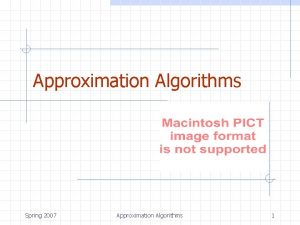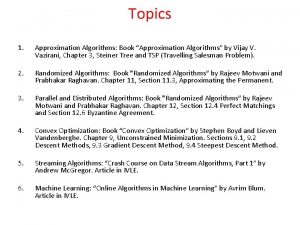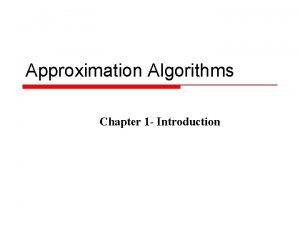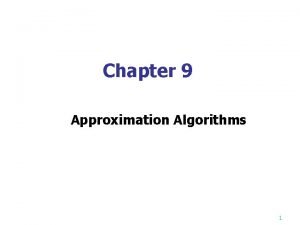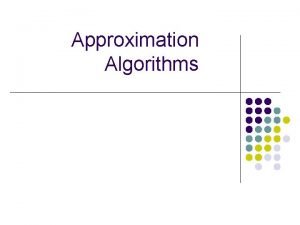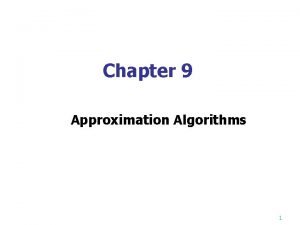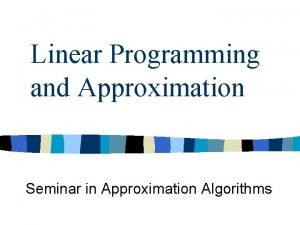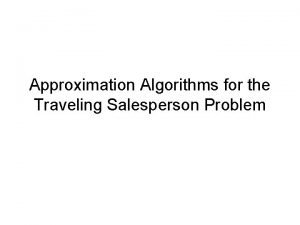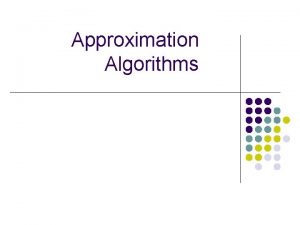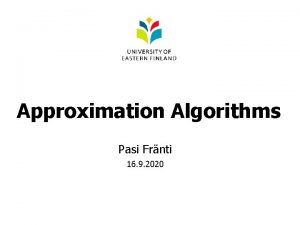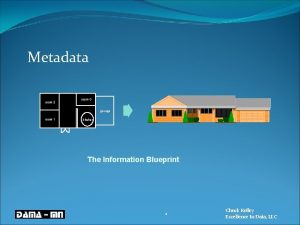Approximation algorithms IM room 344 Friday 17 00

































- Slides: 33

Approximation algorithms IM, room 344 Friday 17: 00 or Saturday 14: 30 Kononov Alexander Veniaminovich 1

We will study NP-hard optimization problem 2

What you should know! • • • Problem Instance Optimization problem Input size of an instance Algorithm Running time Polynomial time algorithm Linear programming (a linear program) NP-hard problem 3

Some books in Combinatorial Optimization • M. R. Garey, D. S. Johnson, Computers and Intractability: A Guide to the Theory of NPCompletness, W. H. Freeman, 1979. • C. H. Papadimitriou, K. Steiglitz, Combinatorial Optimization: Algorithms and Complexity, Prentice Hall INC, Englewood Cliffs, New Jersey, 1982. • Korte B. , Vygen J. , Combinatorial Optimization: theory and algorithms, (Algorithms and Combinatorics 21), Springer, Berlin, 2010. 4

Problem A problem will be a general question to be answered, usually possessing several parameters, or free variables, whose values are left unspecified. A problem Π is described by giving: • a general description of all its parameters, • a statement of what properties the answer, or solution, is required to satisfy. An instance I of a problem is obtained by specifying particular values for all the problem parameters. 5

Input size The input to an algorithm usually consists of a list of numbers. If all these numbers are integers, we can code them in binary representation, using O(log(|a|+2)) bits for storing an integer a. The input size of an instance with rational data is the total number of bits needed for the binary representation. 6

Optimization problem An NP-optimization problem Π is either a minimization or a maximization problem. It consists of: • A set of valid instances, ΩΠ, recognizable in polynomial time. We will assume that all numbers specified in an input are rationals. • Each instance I ΩΠ has a set of feasible solutions SolΠ(I). We require that SolΠ(I) ≠ , and that every solution SolΠ(I) is of length polynomially bounded in |I|. This means that there is a polynomial time algorithm that, given a pair (I, ), decides whether SolΠ(I). • There is a polynomial time computable objective function hΠ, that assigns a nonnegative rational number to each pair (I, ). The objective function is frequently given a physical interpretation, such as cost, length, weight, etc. 7

Optimal solution • An optimal solution for an instance I ΩΠ of minimization (maximization) problem is a feasible solution σ* SolΠ that achieves the smallest (largest) objective function value, i. e. hΠ(I, σ*) ≤ hΠ(I, σ) for all σ SolΠ (I). • We will use OPTΠ(I) or OPT(I) to denote the objective function value of an optimal solution to instance I. 8

Vertex cover • Given an undirected graph G = (V, E), and a cost function on vertices c: V → Q+. • Find a minimum cost vertex cover. • Vertex cover is a set V′ V such that every edge has at least one endpoint incident at V′. 9

Algorithm An algorithm consists of • a set of valid inputs, • a sequence of instructions each of which can be composed of elementary steps, • For each valid input the computation of the algorithm is a uniquely defined finite series of elementary steps which produces a certain output. 10

Running time • The time requirements of an algorithm are conveniently expressed in terms of a single variable, the “size” of a problem instance, which is intended to reflect the amount of input data needed to describe the instance. • The time complexity function for an algorithm expresses its time requirements by giving, for each possible input length, the largest amount of time needed by the algorithm to solve a problem instance of that size. 11

Polynomial algorithm • An algorithm with rational input is said to run in polynomial time if there is an integer k such that it runs in O(xk) time, where x is the input size, and all numbers in intermediate computations can be stored with O(xk) bits. • An algorithm with arbitrary input is said to run in strongly polynomial time if there is an integer k such that it runs in O(nk) time for any input consisting of n numbers and it runs in polynomial time for rational input. • In the case k =1 we have a linear-time algorithm. 12

NP-hard problem • An optimization problem Π is called NP-hard if all problems in NP polynomially reduce to Π. • For any NP-hard problem, there does not exist an exact polynomial-time algorithm, unless P = NP. Almost all interesting optimization problems are NP-hard. 13

What we can do with NP-hard problems? • Solve by enumeration algorithms. • Solve by approximation algorithms: – heuristics, metaheuristics – approximation algorithms with guaranteed worstcase performance ratio. We will study approximation algorithms with guaranteed approximation ratio. 14

Approximation algorithm An ρ-approximation algorithm for an optimization problem is a polynomial-time algorithm that for all instances of the problem produces a solution whose value is within a factor of the value of an optimal solution. 15

Approximation schemes Let Π be a minimization problem. • An approximation scheme for problem Π is a family of (1+ )approximation algorithms Aε for problem Π over all > 0. • A polynomial-time approximation scheme (PTAS) for problem Π is an approximation scheme whose time complexity is polynomial in the input size for the fixed . • A fully polynomial-time approximation scheme (FPTAS) for problem Π is an approximation scheme whose time complexity is polynomial in the input size and also polynomial in 1/ε. 16

Algorithm • How to design an approximation algorithm? – The study of the combinatorial structure of the problem – The study of properties of optimal solutions – The design of algorithms, based on these properties • Generalization and extension of techniques accumulated in the construction of algorithms for polynomially solvable problems. 17

Linear Programming 18

Polynomially solvable problems • • The minimum spanning tree problems The maximum flow problem The assignment problem The maximum weight matching problem ●●● 19

How do we establish the approximation guarantee? • Can we compare the cost of the solution produced by the algorithm with the cost of an optimal solution? . • However, for such problems, not only is it NPhard to find an optimal solution, but it is also NP-hard to compute the cost of an optimal solution. 20

Lower bound • We should find a “good” polynomial time computable lower bound on the cost of an optimal solution. • Moreover, it is interesting that a “good” lower bound usually provides a key step in the design of approximation algorithms. 21

Cardinality vertex cover • Given an undirected graph G = (V, E). • Find a minimum cardinality vertex cover. 22

Maximum and maximal matching Given a graph G = (V, E), a subset of the edges M E is said to be a matching if no two edges of M share an endpoint. • A matching of maximum cardinality in G is called a maximum matching. • A matching that is maximal under inclusion is called a maximal matching. The size of a maximal matching in G provides a lower bound on the size of any vertex cover. This is so because any vertex cover has to pick at least one endpoint of each matched edge. 23

Simple Algorithm 1. Find a maximal matching in G. 2. Output the set of matched vertices. 24

Approximation ratio of the Simple Algorithm Theorem 1. 1 The Simple Algorithm is a factor 2 approximation algorithm for the cardinality vertex cover problem. 25

Proof: • No edge can be left uncovered by the set of vertices picked ― otherwise such an edge could have been added to the matching, contradicting its maximality. • Let M be the matching picked. As argued above, |M| ≤ OPT. • The approximation factor follows from the observation that the cover picked by the algorithm has cardinality 2 |M|. 26

Can we improve the approximation guarantee? – Can the approximation guarantee of the Simple Algorithm be improved by a better analysis? – Can an approximation algorithm with a better guarantee be designed using the lower bounding scheme of the Simple Algorithm, i. e. size of a maximal matching in G? – Is there some other lower bounding method that can lead to an improved approximation guarantee for vertex cover?

Tight example The analysis presented in Theorem 1. 1 is tight.

Can we improve the approximation guarantee? – Can the approximation guarantee of the Simple Algorithm be improved by a better analysis? NO! – Can an approximation algorithm with a better guarantee be designed using the lower bounding scheme of the Simple Algorithm, i. e. size of a maximal matching in G? – Is there some other lower bounding method that can lead to an improved approximation guarantee for vertex cover?

Comparing the cost of the solution with the lower bound

Can we improve the approximation guarantee? – Can the approximation guarantee of the Simple Algorithm be improved by a better analysis? NO! – Can an approximation algorithm with a better guarantee be designed using the lower bounding scheme of the Simple Algorithm, i. e. size of a maximal matching in G? NO! – Is there some other lower bounding method that can lead to an improved approximation guarantee for vertex cover?

Books • Кононов А. В. , Кононова П. А. Приближенные алгоритмы для NP-трудных задач, Учебное пособие, НГУ, 2014. • Approximation Algorithms for NP-hard problems, edited by D. Hochbaum, PWS Publishing Company, 1997. • V. Vazirani Approximation Algorithms, Springer-Verlag, Berlin, 2001. • P. Schuurman, G. Woeginger Approximation Schemes – A Tutorial, chapter of the book “Lecture on Scheduling”, to appear in 2008. • D. P. Williamson, D. B. Shmoys The Design of Approximation Algorithms, Cambridge University Press, 2011. 32

Exercises 1. Consider the following problem. Problem MST: Given an undirected graph G = (V, E), weights of edges c: E → Q and positive rational number B. Is there a spanning tree of weight B or less in G. Whether problem MST belongs to NP. Explain your answer. 2. Formulate the cardinality vertex cover problem as an integer problem. 3. Obtain the dual program for the LP-relaxation of the integer problem from exercise 2. 33
 Baripity
Baripity Lru approximation page replacement algorithm
Lru approximation page replacement algorithm Approximation algorithms for np-hard problems
Approximation algorithms for np-hard problems Approximation algorithms vazirani
Approximation algorithms vazirani Ai 344
Ai 344 Swen344
Swen344 Swen 344
Swen 344 Photography merit badge pamphlet
Photography merit badge pamphlet Bmo 344
Bmo 344 Cse 332 uw
Cse 332 uw Biology 344
Biology 344 Swen 344 rit
Swen 344 rit Screen truepress 344
Screen truepress 344 Rough endoplasmic reticulum diagram a level biology
Rough endoplasmic reticulum diagram a level biology Swen344
Swen344 Swen 344
Swen 344 Hotel database sql queries
Hotel database sql queries ____________________ there a bedroom downstairs?
____________________ there a bedroom downstairs? Room 19 summary
Room 19 summary First born approximation
First born approximation Binomial expansion of partial fractions
Binomial expansion of partial fractions Continuous least squares approximation
Continuous least squares approximation Normal curve approximation
Normal curve approximation Euler's method formula
Euler's method formula Muscle approximation
Muscle approximation Tanh approximation
Tanh approximation Trapezoid rule
Trapezoid rule Interpolation and approximation of curves in cad
Interpolation and approximation of curves in cad What does approximation mean
What does approximation mean What is covalent catalysis
What is covalent catalysis Born oppenheimer approximation
Born oppenheimer approximation When does newton's method fail
When does newton's method fail Diode approximation
Diode approximation Divms uiowa
Divms uiowa

